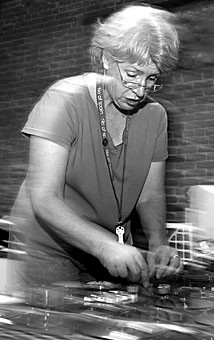Students, faculty and staff are being asked to donate everyday items to be used in a new artwork to be displayed in the Student Union Memorial Center.
The third and final work by artist Susan Gamble, commissioned by the UA for the SUMC, is being completed with the donations of students’ everyday items, said Christina Lieberman, the senior coordinator for campus activities and Union Galleries.
The work comprises three separate steel frames filled with the donated materials, measuring 9 feet by 9 feet, 10-by-10 and 11-by-11, respectively, and will be mounted above Wilbur’s Underground at the second, third and fourth floors, Lieberman said.
Gamble said the work is meant to convey “”communication and the transfer of knowledge,”” and evaluate technology and its endurance in society.
“”Cell phones, for example, have vastly changed. How many years will it be before the cell phones here become laughable?”” Gamble said.
“”The more materials I can get from the campus, the better,”” Gamble said. “”If anybody has an old Walkman or CD player, or anything leading up to the MP3s, that would be great. Just look at how much that has changed.””
By using everyday items, the art will reflect different aspects of the university community, Gamble said.
Student, faculty and staff have all reacted very enthusiastically to the newest addition to the SUMC’s public art, but only enough materials to fill up a single grocery bag have been donated, said Lieberman.
“”I don’t really care what people’s reactions are as long as they’re talking about it because it helps them process what their values are,”” Lieberman said. “”Because of the fact that it is made of everyday objects, a lot of people challenge whether or not it’s really art.””
The donations have been standard everyday items such as pens and now-obsolete floppy discs but haven’t really hit the variety the project intends, Lieberman said.
“”One thing that isn’t in here is an iPod, but we want one that isn’t working so somebody doesn’t try to get it and risk their life,”” Lieberman said. “”It would be a shame if one wasn’t in there.””
More materials that are specific to the university, such as test tubes, calculators, art supplies and everyday materials that different fields of study use would be ideal, Lieberman said.
“”Our hope is that every student will look at this and think, ‘Hey, I use that’,”” Lieberman said. “”Everybody has that one thing they always carry around with them, and if they donate that sort of item then it would be preserved in these pieces of art for generations to come.””
Luis Quijada, an architecture freshman, said the piece is interesting and unique because it was made of materials that most people have used, such as CD-Rs, newspapers, pencils and old cellular phones.
“”I’ve never seen anything like it before,”” Quijada said. “”It represents everything that we use and how we live, plus it’s school oriented.””
Not all students seemed to share such positive opinions on the piece.
“”It’s ugly,”” said Nicole Theberge, an engineering physics senior. “”It looks out of place against the cream walls. Maybe that’s why I find it so hideous, because it feels like you almost run into it.””
April Abate, a microbiology senior, said the artwork was pretty and creative.
“”It tended to be expressive of some cultural background,”” Abate said. “”It reminded me of Indian attire.””
The university is not advertising that students can donate materials for the artwork very well, Abate said.
“”It’s a cool idea to unite the campus, getting everybody involved, but how are you supposed to find out about it?”” Abate asked.
Mariana Vazquez, a UA alumna, said she noticed the piece as she walked to work, but she didn’t read the information plaque beside the piece.
“”It’s great for people who actually pay attention,”” Vazquez said. “”I noticed it kind of just because I was walking by, and originally I thought it was just really random.””
There is no question that it is art, Vazquez said.
“”My parents have a water fountain on canvas that is made of newspaper, so my opinion is that pretty much anything can be used to make art.””
Gamble does her steel and ceramic work at Santa Theresa Tile Works, 440 N. Sixth Ave., and was the artist responsible for the other two public art pieces in the SUMC, “”Spire 1″” on the James E. Rogers Plaza and the “”USS Arizona Memorial Spire”” located in the James E. Rogers Circle.
The three public art pieces were commissioned as part of the Percent for Arts Legislation, which set aside 0.5 percent of the total funds used to construct the SUMC, which comes out to $300,000, Lieberman said.
“”This concept is specific for the Student Union,”” Gamble said. “”I can work with different, less durable materials, since this is located in the atrium area, but I’m still creating in the same way that I create art from ceramic tiles.””
The one completed piece is being displayed temporarily on the third floor of the SUMC to gauge student reactions and to see how it holds up in the summer weather, Lieberman said.
Lieberman added that students can bring donated items for the artwork to her office in the Center for Student Involvement and Leadership in the SUMC.









